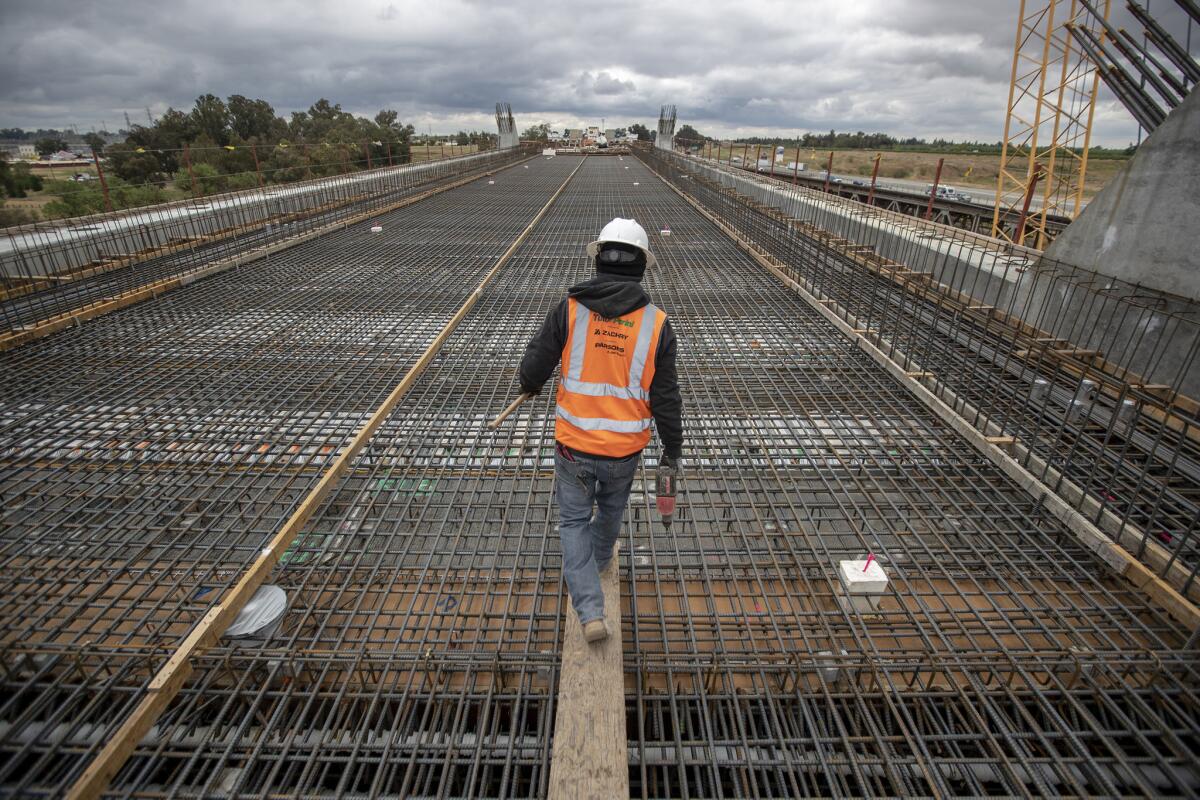Costs for California’s high-speed rail project may increase by $1.8 billion

- Share via
The cost of building a 119-mile section of the California bullet train in the Central Valley is projected to increase by $1.8 billion, taking the total to $12.4 billion, according an internal draft report by the state rail authority’s staff.
The estimate was made in preparation for a project update that the rail authority is scheduled to release to the Legislature on Wednesday, detailing a plan by Gov. Gavin Newsom to build a partial high-speed system running from Bakersfield to Merced.
The draft report projects that the cost of building that partial operating system, including the 119-mile section now under construction, would be $20.4 billion.
The report projects that the rail authority would complete it between 2026 and 2030. The contents of the draft report were described by an official close to the project, who asked not to be identified because he was not authorized to discuss it.
The rail authority staff had prepared the report for its board meeting on April 18, though the estimates were not discussed. Since they are contained in a draft document, they could be revised when the project update is released on Wednesday.
Gov. Gavin Newsom called for building the Bakersfield to Merced system earlier this year, saying the full $77-billion project to connect Los Angeles to San Francisco with 220-mph trains had no funding or realistic plan for completion.
But the slimmed down Central Valley project raises critical questions, such as its construction cost, schedule, ridership and operating costs versus revenues. The staff report and a parallel one by Deutsche Bahn Engineering and Consulting, which is advising the state under its role as the “early train operator,” outlined some of the challenges to Newsom’s plan.
Newsom told the Times earlier this month that he wants to curtail the role of consultants, criticizing their performance, though the report does not address any of those plans.
The construction of a Bakersfield to Merced operating segment depends, the report says, on no further cost increases, an appropriation by the Legislature of all remaining funds from a 2008 bond and the retention of federal grants that the Trump Administration wants to terminate.
The $1.8-billion cost increase covers bridges, viaducts, trenches and roadbed from Madera to Wasco, a distance of 119 miles. That includes $477 million for actual cost increases, $362 million for increases in scope of the project and nearly $1 billion for additional contingencies to manage risk.
Central Valley costs have been growing for years. Originally, the rail authority had planned to build about 130 miles of track from Madera to Bakersfield for about $6 billion. Now the construction ends north of Bakersfield near Wasco. The cost of land acquisition, utility relocations and environmental assessments, among other items, have grown sharply.
The $20.4-billion cost to build the Bakersfield to Merced line would take almost all of the rail authority’s funding through 2030. It includes all the bonds that taxpayers approved in 2008, all the federal grants provided by the Obama Administration and all of the 25% share of greenhouse-gas fees that the state collects in quarterly auctions. It is unclear how the rail authority would complete the partial operating segment by 2026 on funding that does not arrive fully until 2030.
Once it begins operating, the bullet train would carry 1.7 million riders, the report projects. It is not clear whether that prediction would be included in the project update on Wednesday. It would connect with the existing San Joaquin diesel-powered rail service operated by Amtrak and the Altamont Corridor Express, or ACE, that would run from Merced to San Jose. That would create a link, though a slow one, from Silicon Valley to the Central Valley.
The analysis projects ridership would double on those rail lines as a result of the bullet train.The combined services of all three lines would lose $63 million, though that would be less of a loss than ACE and San Joaquin would sustain without the high-speed rail.
Whether the Newsom plan will fly or not will depend partly on how much support it gets from Bay Area and Southern California political leaders.
The Metropolitan Transportation Authority had considered this month adopting a resolution to ask the rail authority for a fresh assessment of spending more money in the Central Valley and to “prioritize” investments in Southern California. The resolution was pulled off the April agenda at the last minute.
Ara Najarian, a MTA board member and a Glendale councilman, said he grew immediately worried after Newsom announced cutbacks in the program at his state of the state speech.
Najarian and others want funding to improve the existing commuter rail service operated by Metrolink to Palmdale, allowing it to eventually serve as the connection to the bullet train system.
“We are concerned that the money for this will be grabbed by Northern California,” he said. “We expect money to improve our system.”
Some Bay Area leaders are also growing more concerned, because the Newsom plan failed to find funding to build a high-speed rail line from San Jose through Gilroy to the Central Valley.
But the rail authority has not backed off on any of its commitments to Southern California, said rail authority spokeswoman Annie Parker. She cited a lengthy list of state-funded projects, including new tracks at Union Station, that will speed movements in and out of passenger platforms.
Separately, Michelle Boehm, Southern California regional director of the high-speed rail project, is leaving the program, it was learned. Parker confirmed she has accepted another position.
Follow me on Twitter @rvartabedian
More to Read
Sign up for Essential California
The most important California stories and recommendations in your inbox every morning.
You may occasionally receive promotional content from the Los Angeles Times.











